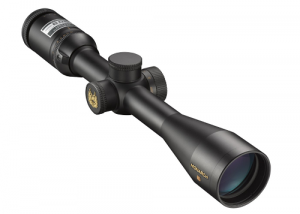Table of Contents
ToggleRifle Scopes for Hunting review will provide you with everything you need to know to select the best hunting scope for your rifle. After the scope suggestions we will give you a solid way to pick a quality rifle scope. You will learn what to avoid and how to pick a top-rated Rifle Scopes for Hunting.
Best 4 Rife Scopes for Hunting in 2025
| Nikon 3-9×40 BDC | Nikon Monarch 3 BDC 3-12×42 | Vortex Optics Diamondback 4-12×40 | Nikon Buckmasters II 4-12×40 BDC |
|---|---|---|---|
 |  |  |  |
| Best Budget Scope | Best of the Best | Runner Up | Editor’s Choice |
| The Nikon 3-9×40 BDC Riflescope features fully multi-coated lenses to boost light transmission for dawn-to-dusk performance. | It is engineered to provide a clear and incredibly sharp sight picture between dawn and dusk. With spring-loaded instant zero-reset turrets, offers shooters to easily make adjustments on the fly. | Dead-Hold BDC reticle has a customized design that helps eliminate guesswork on hold-over and windage corrections. Good for any hunting or shooting at varying ranges. | The Buckmasters II series offers the brightness and clarity of Nikon’s Fully Multi coated lenses, as well as the generous eye relief, 100-yards parallax setting and Nikon’s popular BDC reticle. |
| Buy Now | Buy Now | Buy Now | Buy Now |
1. Best in Budget – Nikon 3-9×40 BDC Reticle Black Riflescope (16558)

- Multiple Layers of Anti-Reflective Coating maximize light transmission, brightness and contrast for an extremely bright sight picture.
- Constructed of Aircraft-grade aluminum with Type-III hard anodizing surface finish for maximum strength-to-weight ratio and optimum ruggedness.
- Positive-1/4-inch click adjustments get you zeroed in quicker and maintain your setting even with heavy recoil.
- O-ring sealed to prevent moisture from entering body and nitrogen purged for total reliability against thermal shock.
- Shockproof construction shrugs off hard recoil and rugged use.
- The Spot On optimized BDC reticle makes accurate shots to 600 yards and beyond a real possibility.
- Built on a 1″ tube, the Nikon 3-9×40 BDC Riflescope is waterproof, fog proof, and shockproof.
2. Nikon Monarch 3 BDC Riflescope, Black, 3-12×42

- MONARCH 3 – 12×42
- Eye Box Technology with 4-time zoom range and up to four Inch of eye relief
- Adjustments are made easy with Spring-Loaded Instant Zero-Reset Turrets
- A quick focus eyepiece allows the shooter to instantly bring the object into focus
- Ultra ClearCoat Optical System for up to 95% light transmission
- Optimized for use with Nikon’s Spot On Ballistic Match Technology
- MONARCH 3 is waterproof, fog proof and shockproof.
Con: Expensive : This is the best scope we could recommend. If you want all the bells and whistles, this is the one to buy. It has great quality and the Nikon’s Spot On Ballistic Match Technology which offers Spot On Technology website to print out ballistics charts that’ll let you know where to aim. This is super helpful and incredibly easy.
3. Vortex Optics Diamondback 4-12×40

- The Diamondback 4-12×40 riflescope is one of multiple configurations in the Diamondback lineup and is ideal for big game, predator/varmint, muzzleloader, slug shotgun, and long range applications.
- Lenses are fully multi-coated for crystal clear, bright images from dawn till dusk. The fast focus eyepiece allows for quick and easy reticle focusing.
- A precision glide erector system ensures accurate tracking and repeatability.
- A solid one-piece tube with a hard anodized finish creates a shockproof and durable scope while helping camouflage the shooter’s position. Argon purged and o-ring sealed the scope will deliver a lifetime of fog proof and waterproof performance.
4. Editor Choice – Nikon Buckmasters II, 4-12x40mm, BDC, Riflescope

- Extremely bright sight picture: Allows for high-resolution images even when hunting in the least desirable conditions
- Fully multi-coated lenses offer increased light transmission for dawn to dusk brightness
- Patented BDC reticle Versatile magnification range offers the flexibility needed for any type of hunting situation
- Generous, consistent eye relief
- Precise hand-turn 1/4″ @ 100 yds positive-click adjustments get you zeroed in quicker and maintain your setting even with heavy recoil
- Waterproof, fogproof and shockproof
One person’s review: Best Scope for the money. The Glass is Clear. Quality is Great. The BDC is Spot-On. The Spot-On app works amazing with this scope. I later purchased a 4-16 scope made by another company. It can’t TOUCH this Buckmaster scope. I am a Nikon Fan and it did Not Disappoint. I looked through a few other guys at the Range scopes (Big Dollar) and none of them were better than this Nikon. I use it on my Remington 700 ADL in 223 and shoot 600 yards with it No Problem.
How to Choose the Best Rifle Scopes for Hunting
Let me guide you through the steps to choosing the best hunting scope. Let’s look at the elements that will give you the wisdom to make a wise choice for a Rifle Scopes for Hunting for you.
The Tube
Your scope will have a tube that contains the lenses and lets the light through. This is the unit that will determine the structural integrity. The tube is responsible for housing the interior lenses and reticles as well as providing the structural integrity of the scope. Most hunters are going to need nothing more than the standard 1” main tube which measures 30mm. These scopes are by far the most common size tube and their accessories are numerous. The larger the tube the more light will be allowed in and you will increase the ability to adjust for long-distance. Only those who are wanting to compete for top marksmanship will need this type of tube. You most likely will not need this level of adjustability for hunting. The scopes that have a larger main tube than the common 1” are more expensive and have fewer options for attachments, mounting rings and adapters. Stick with the common 1” tube if at all possible.
Gas Filled
The inexpensive scopes are filled with air. A scope that is filled with air, not gas can be accessible to particles and fog in the tube. You will want to get a scope that is filled with gas like nitrogen. This will make sure the air inside the scope will not be fogged up by temperature changes and is perfectly clean of debris.
Objective Lens
The front lens is the objective lens. The objective lens will range from 20mm up to 80mm. This is the most important lens of the scope.
By increasing the size of the lens you could increase;
- Increase the ability to see more clearly in low light situations
- Increase the size of the image in view
- Increased clarity of the image in view
The larger the objective lens you have will bring some disadvantages:
The cost will probably go up. They are more expensive to produce. Of course the larger the lens the heavier the weight. The hardware to mount the heavier lens will be more costly. The overall weight of the rifle will be heavier and a bit bulkier.
Don’t be fooled. A cheap scope that contains an objective lens that is larger yet poor in quality will not be as good as a smaller lens that is well made. The experts will tell you the best hunting rifle scopes are ones that focus on the quality of the glass first and the size of optics second.
The Quality of the Glass is Most Important – Rifle Scopes for Hunting
Arguably the single most important factor of a quality long-range hunting scope is the glass itself. This glass is responsible for gathering, transmitting, and focusing every single little ray of light into your eye. If this process is interrupted, you’ll be off with your shot. Often you’ll run into terms like High Density (HD) or Extra-Low Dispersion (ED) glass. Many manufacturers have different terms for their glass quality but don’t get fooled. Just because a company puts fancy sales language on it doesn’t make it good glass. To find out how good the glass in your scope maybe, head to the manufacturer’s website and do some research. If they have poor information, bad reviews, or no website at all chances are good they’re using cheap junk. Great manufacturers have quality websites, good videos, and clear information that won’t mislead you in a purchase. They should explain what it’s made from and how their glassworks. Of course, you may still be able to get an acceptable scope from an “unknown” manufacturer but it can sometimes feel like a guessing game to figure out the details of the scope you’re looking at.
Lens Coatings
You’re going to immediately see this information in every scope listing. When you’re shopping for optics expect to get overloaded with “coated” this and “multi-coated” that. There are 5 levels of lens coating and they’re all meant to increase the absorption of light and minimize reflection of light off the objective lens. That said, some advanced coating can be applied to interior surfaces for other purposes.
Uncoated
Has no coating and performs poorly due to reflection of light off the front glass.
Coated
Coated lenses usually have a single layer of light-absorbing material deposited on the surface of the glass. This is better than uncoated, but not great by today’s standards.
Fully-coated
Fully-coated lenses may have improved coatings or advanced coating types. These are slim improvements over a coated lens and often unclear by the manufacturer.
Multi-coated
Multi-coated lenses have more than one lens coating. This may be absorptive coatings, fog proof coatings, or scratch-resistant coating among others. They may also have more than one type of absorptive coating.
Fully Multi-coated
Fully multi-coated lenses are coated to absorb all wavelengths of light properly. They may also have other types of coatings involved. These are the best coatings available today. It’s common that cheap scopes have a coated objective and uncoated internal lenses. This can really ruin the overall quality of the scope because internal surfaces may reflect all that light that the objective lens worked so hard to gather up! The result is as poor of an image as if nothing were coated, to begin with.
Reticle Types
There are so many crosshair types these days for scopes that it would be silly of me to try to list them all. Instead, I’ll give you a few things to think about when you start selecting the reticle that’s going to do the work for your scope.
The Target
For close or fast-moving objects a thicker and easier to acquire reticle is probably best. Thick crosshairs or a dot style reticle of some type will most likely provide great results for your next hunt. In the midrange, you’ll want a reticle that’s sized down a bit so it won’t cover up too much of your target. However, there’s a good chance you’ll still be taking a slightly moving shot or a quick shot. Your preference will determine if you want a larger or small reticle for these. Long-range shooting or targeting small animals like rodents and varmints means using a thin crosshair or reticle. Large reticles will cover up too much of your target on small animals or at great distances. For windage and elevation, nothing is more common than the mil-dot reticle. There are other options out there, though mostly for target shooting and not hunting.
Magnification
Understanding the magnification is something many do not really understand. The goal is to bring the object into a view that gives us enough clarity and makes the object larger to the point you can make an accurate shot. Typically most scopes have a 3:1 or 4:1 zoom in ratio. For every 100 yards you will have a 3-4x enlargement of the object. A 3-9x power will give you enough enlargement and clarity up to 300 yards. So this is the most common size scope because most hunters rifles are accurate at this range. The scopes with higher power will increase the size of the image and make the image clearer and easier to pick the spot on the object you are trying to hit. The higher the power the harder it is to quickly locate the object in the scope.
Turrets and Adjustments
These are the tools on the scope used to sight it in and determine the accuracy of your shot. All scopes have to be sighted in when mounted. The Turrets have adjustment intervals and the common adjustment is ⅛ or ¼ inch. Some scopes are set and you simply make sight adjustments based on range and wind. The better scopes have turrets that can be adjusted in the field based on wind direction and speed and yardage. The tactical mil style adjustments are great for the expert or highly advanced shooters. But they take quite a bit of practice and experience to get proficient at this. Most of us hunters do not need this. The less I have to do to get the target in sight the better I like it.
Conclusion
Hopefully, our review has made the selection process easier for you. It’s not hard to pick a great scope for the price point you have available. Take the advice of people who are using and recommending the best scope you can afford.



